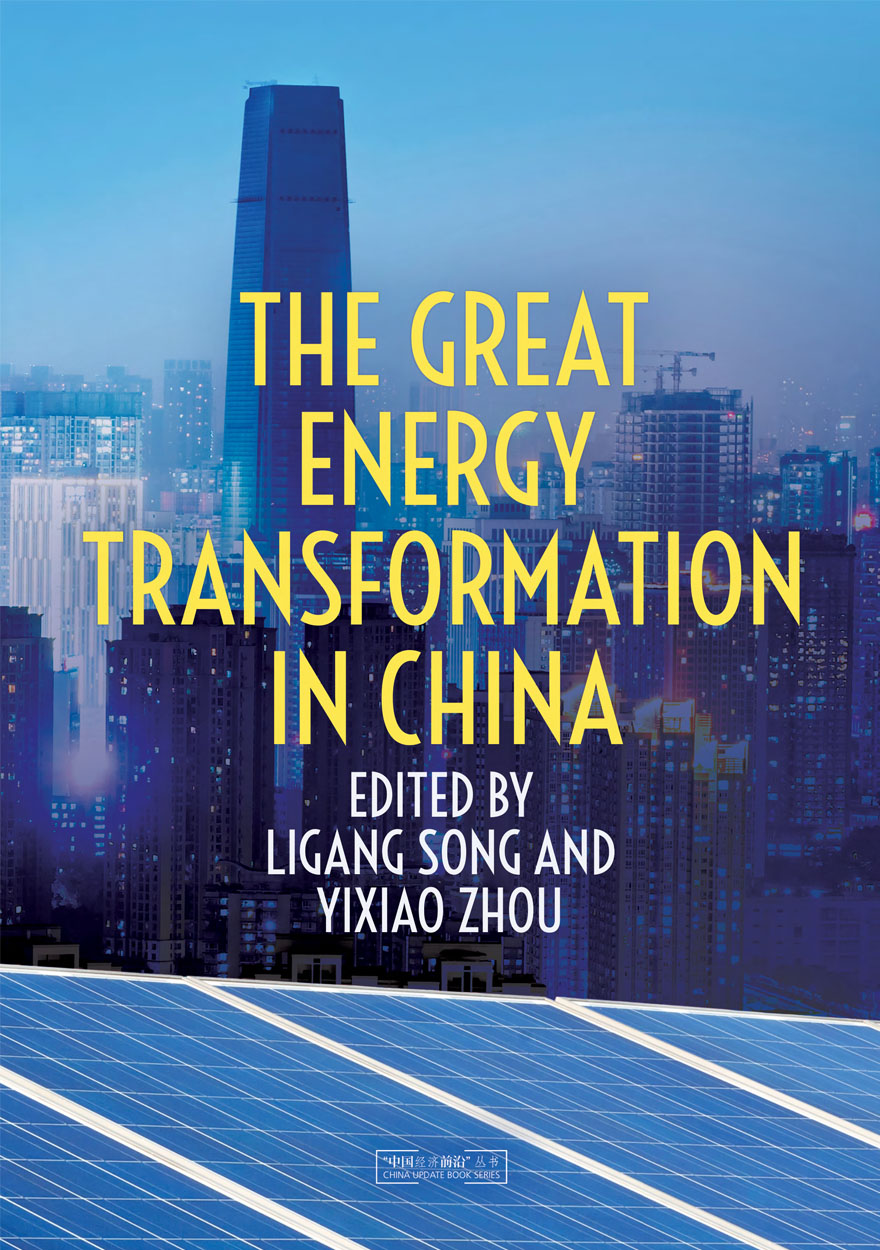Yixiao Zhou
Yixiao Zhou is Associate Professor of Economics and Director of China Economy Program, Crawford School of Public Policy, The Australian National University.

The Great Energy Transformation in China »
Edited by: Ligang Song, Yixiao Zhou
Publication date: November 2025
In 2020, China started the drive to commence a reduction in carbon emissions by 2030 and reach carbon neutrality by 2060, setting in motion a transition to a green, sustainable and clean economy. China has ambitiously developed clean energy alternatives to coal. This transformation encompasses multifaceted strategies ranging from investment in renewable energy and the development of low-emission technologies to more stringent policy regulations on emissions. Renewable energy sources like hydroelectric power, wind, solar and biomass have received substantial attention and investment, with China emerging as a global leader in renewable energy capacity.
In the technology space, China’s transitioning to electric vehicles (EVs) has catalysed the development of a robust EV market, fostering innovation in battery technology and charging infrastructure. China has now become the largest exporter of EVs in the world market. These developments have the potential to materially help curb the world’s carbon footprint and mitigate environmental degradation.
Nevertheless, challenges persist domestically, including the need for grid modernisation to accommodate intermittent renewable energy sources and addressing the socio-economic impacts on coal-dependent regions. In the international market, China’s efforts towards a cleaner and more sustainable energy landscape have helped position it as a leader in sustainable economic development. This could enhance trade of green products, the development of global renewable energy and international investments in energy transformation. However, global trade and investment in green technologies and products are faced with rising geopolitical tensions and trade protectionism. This book discusses China’s achievements in its transition towards renewable energies and identifies new opportunities and challenges for deepening energy transformation in China.

China: Regaining Growth Momentum after the Pandemic »
Edited by: Ligang Song, Yixiao Zhou
Publication date: December 2024
The slower growth of the Chinese economy in the aftermath of the pandemic has prompted the Chinese Government to adopt measures to boost domestic consumption and deepen structural reform, with the effectiveness of such policies beginning to be felt. However, China still faces challenges that will affect its growth dynamics down the track. These include the slowdown of its real estate sector, the complex internal and external environments for macroeconomic policy, the high level of income inequality, weak growth in investment by the private sector, negative population growth, high levels of debt, deglobalisation, weakness in the financial sector and equity markets, the inadequacy of its fiscal system and the imperative to decarbonise the economy. China must confront these challenges to maintain growth momentum and achieve higher levels of income and living standards.
The theme of the 2024 China Update book is China: Regaining Growth Momentum after the Pandemic. It discusses some of the challenges and policy issues that are being watched with keen interest by decision-makers and markets alike, including: What are the obstacles to economic growth in the aftermath of the pandemic and how can these be overcome? What are the key challenges and opportunities for China to move to the next level of development against the backdrop of negative population growth? Is it time for a Tax-Sharing System Reform 2.0 to consolidate China’s fiscal position? What are the challenges facing China’s small and medium enterprises? How is China’s business environment faring, and what are the implications for investment? How does China’s urban housing affordability impact its low fertility rate? How will the trade conflict between China and the United States play out regarding semiconductors and other high-tech products? How does China–Africa bilateral agricultural trade impact on African rural transformation?

China’s Transition to a New Phase of Development »
Edited by: Ligang Song, Yixiao Zhou
Publication date: November 2022
The Chinese economy is currently undergoing fundamental changes. In this context, the 2022 China Update examines the key characteristics of China’s transition towards a new phase of economic growth and development. This year’s update book covers a range of diverse topics that reflect the complex and changing nature of the economy. It explores critical questions: Why does China need a new development paradigm, and what is the best way to achieve it? What are China’s choices when faced with the restructuring of global industrial value chains? What key roles will domestic consumption play in the next phase of China’s development? What does the digital transformation mean for the Chinese economy? What has been the domestic impact of the Covid-19 pandemic on income inequality and labour market outcomes? What pathways exist for China in its transition towards carbon neutrality? How does China’s emissions-trading market compare with that of Europe? How will China’s carbon neutrality strategy affect the Australian economy? What are the political factors influencing bilateral trade flows between China and its trading partners? And what is at stake for China–US relations?

China’s Challenges in Moving towards a High-income Economy »
Edited by: Ligang Song, Yixiao Zhou
Publication date: September 2021
With its per capita income surpassing US$10,000, China has now drawn up ambitious plans to further lift its income to the level of developed countries. Yet various constraints need to be overcome if China is to build on the achievements of the last 40 years and further boost its growth potential. Besides these constraints, the year 2020 saw human societies hit heavily by the COVID-19 pandemic and the global economy caught off guard and dipped into recessions caused by lockdown measures for controlling the spread of the pandemic. Nations around the world have experienced grave loss of human life and lockdown measures have knocked economies from their normal growth trajectories. Even as the pandemic continues to unfold, all signs point to China as being the first major economy to have emerged out of the crisis. But many questions remain. Has the Chinese economy emerged from the pandemic crisis relatively unscathed? What are the long-term prospects for its economy? This year’s Update book, China’s Challenges in Moving towards a High-income Economy, explores the challenges faced by the Chinese economy in the transition towards a high-income economy, including agricultural development, finance and fiscal system reform, RMB internationalisation, trends in urbanisation, as well as topics related to innovation, corporate sector development and market competition. China’s growth experience has been full of exciting changes and important lessons for reform and structural changes, and this year’s China Update is again the way to gain insights into these.

The Chinese Economic Transformation »
Views from Young Economists
Edited by: Ligang Song, Yixiao Zhou, Luke Hurst
Publication date: July 2019
The Chinese Economic Transformation, the 19th volume in the China Update book series, provides an opportunity for young economists to share their views on various issues relating to the Chinese economic transformation. More than half of the contributors to this book are female scholars. Some of the contributors are rising stars in the studies of the Chinese economy and economic transition, and some only recently received their PhDs and are on their way to establishing themselves in the field of China studies. But they have one thing in common: to passionately observe, study and research what is going on in the Chinese economic transformation during the reform period; and, by so doing, make contributions to the policy debates on, and general understanding of, the Chinese economy.
The chapters in this volume include an in-depth probe into challenges in capital and credit allocation due to financial friction and policy distortions; investigating the causes of growth slow-down in China and suitable policy responses; the evolution of the household registration system and its impact on off-farm employment and the integration of rural and urban labour markets; the growth, scale and characteristics of nonstandard employment; the development of rural e-commerce and its economic impact; innovation performance of listed enterprises in China; financial services liberalisation and its impact on firms’ performance; financing support schemes for small and medium-sized enterprises (SMEs) and the effect on banks’ credit allocation to SMEs; the potential costs of US–China trade conflict and ways to mitigate them; gender income gap in China’s labour market; causes of blockage of Chinese overseas direct investment and strategies to reduce the probability of encountering obstacles; and the role of state capital in the iron ore boom in Australia.
The great variety of topics in this year’s Update allows readers to understand the current shape of the Chinese economy and to think deeply about policies and necessary reforms for future growth and development.



